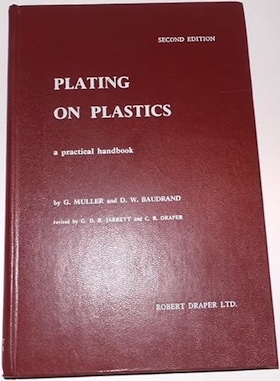
-----
Repairing chrome plated plastic
Q. I am interested in learning more about the process involved to replate / repair plastic automotive parts with chrome. What are the basic different types of technology, who supplies raw materials and training? I had a headlamp apart several years ago, which was plastic, the reflector was very similar to chrome, but looked to be a spray applied material,
who supplies this material? Is it also used for decorative purposes on plastic automotive trim? I have considerable experience in the industrial coatings field, and am considering looking into providing this service to old car enthusiasts such as myself.
Canada
1999
by John McDermott

on eBay or Amazon
or AbeBooks
(affil link)
Hi, T.
Yes, there are three common ways of applying a reflective look to plastic --
The first would be real copper-nickel-chrome electroplating. This is currently done on most automotive grills because it is a premium, robust finish which will stand up to the extremes of automotive exposure including road salt and abrasion. But this is a very expensive, very complex process involving many steps to clean, etch, and activate the plastic for electroless plating, followed by copper, nickel, and chrome electroplating. Tail light bezels, emblems, and trim may be done similarly. We offer an Introduction to Chrome Plating which will briefly explain that subject. If possible, try to get your hands on "Standards and Guidelines for Electroplated Plastic" although it's out of print and hard to find, or another plating on plastic book.
The reflective finish inside a headlamp is not actually chrome plated plastic for two reasons: first, it doesn't need to be robust because it is sealed behind a lens and not exposed to the environment. Second, as bright and beautiful as chrome plating is, it is actually a very poor reflector because it absorbs certain light frequencies. You've probably seen how hot chrome gets in the sun due to that fact. The finish on the reflectors is probably vacuum metallized aluminum (unless it is an old and horribly expensive car like a Rolls-Royce, in which case it might be rhodium electroplating). Vacuum metallizing is a three step process: a base coat of paint is applied; the parts are placed in a vacuum chamber where a very thin layer of aluminum deposits on them; then a clear coat is applied to protect that very thin aluminum.
The third method, more recently developed, is chrome-look paint, sometimes called "spray chrome", although chrome is not actually involved at all. This is very similar to the vacuum metallizing process, employing a base layer, the metallizing step, and the protective clear coat -- the difference being that the middle layer (the bright layer) is applied with spray paint equipment rather than in a vacuum chamber. The bright layer can be very thin aluminum flakes but is more commonly a silver layer applied the same way silvering is done on a mirror -- simultaneous spraying of silver nitrate and a reducing agent.
Vacuum metallizing and "spray chrome" achieve quite similar results, with OEMs using the vacuum metallizing because it involves far lower labor costs than the meticulous spraying process, but hobbyists using the spraying process because it involves far lower capital costs than multi-million dollar vacuum chambers. Although "spray chrome" parts will not be the equal of real chrome plated plastic, the process is easier, more affordable, and these days sometimes used as a chrome plating substitute. This is something you could investigate doing, whereas real chrome plating on plastic might require a multi-million dollar investment
Good luck with the enterprise.
Regards,

Ted Mooney, P.E.
Striving to live Aloha
finishing.com - Pine Beach, New Jersey
Ted is available for instant help
or longer-term assistance.
Q. I have a plastic piece that is "chrome plated." Unfortunately, it has scratches in the chrome which show the black plastic beneath it.
Is there any way to repair the scratches or cover them up?
Thank you.
hobbyist - Hullabaloo, Alaska, USA
2005
A. A perfect repair is probably not possible, but it would help a great deal to know what the "piece" is because it might give a hint about what the construction is (type of plastic, real chrome plating vs. vacuum metallizing, etc., and the exposure conditions it needs to stand up to). "Chrome" nail polish is probably the most accessible and least expensive repair, but would only be satisfactory for very benign exposure and if acetone doesn't degrade the particular type of plastic. Beyond that there is spray paint in chrome color like "bumper chrome" ⇦ on eBay or Amazon [affil link] , and several more exotic solutions. I think the object should be to reduce how the scratch stands out rather than to expect an actual repair.

Ted Mooney, P.E.
Striving to live Aloha
finishing.com - Pine Beach, New Jersey
Ted is available for instant help
or longer-term assistance.
Q, A, or Comment on THIS thread -or- Start a NEW Thread

